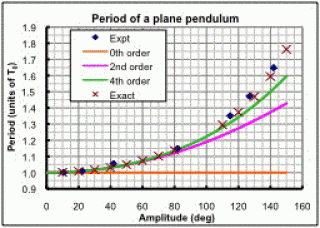You are here: start » activities » main
Pendulum Period Calculation (Power Series)
Highlights of the activity
- This small group activity is designed to help upper-division undergraduate students understand the quantitative relationship between the period and amplitude for a plane pendulum.
- Students derive the expression for the period of a plane pendulum from the equations of motion, evaluate the integral expression numerically using series expansion, and plot the experimental and numerical results on the same graph.
- The wrap-up discussion focuses on constants/parameters and the impact of higher order terms.
Reasons to spend class time on the activity
The potential energy diagram approach has yielded a method of calculating the pendulum period based on the model chosen for the appropriate potential $U(\theta)\approx sin(\theta)$. Students now calculate the quantitative prediction of the model. This forms a basis to evaluate the validity of the model based on their experimental data.
The series approximation to the evaluation of the period integral requires many steps, and much intervention and class discussion is required. The calculation represents a new level of sophistication for most students. They practice series expansion skills acquired in the “Idealizations and Symmetries” course. The series expansion method shows that successive approximation really does work.
